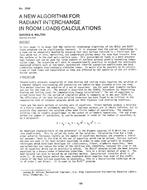Many newly constructed homes, market-based retrofitted homes, and existing homes receiving U.S. Department of Energy (DOE) lowincomeweatherization improvements are now required to have 62.2-compliant ventilation systems to reduce concentrations of indoor air pollutantsto acceptable levels (Walker and Sherman 2008). However, when 62.2 ventilation systems are installed and operating continuously24/7/365, o ver-ventilation can occur under extreme outside temperature conditions, especially in “leakier” homes. Previous researchrecommendations (Temple and Holton 2003; Persily and Martin 2000; and Walker and Sherman 2008) support further investigation intoenergy savings from the use of temperature-based, whole-house ventilation controls. A proposal to ASHRAE SSPC 62.2 would allow wholehouseventilation system design flow rates and/or run times to be adjusted based on estimated stack-induced infiltration. Reducing mechanicalventilation during periods of stack-induced “over-ventilation” reduces space conditioning and ventilation fan energy use. The control may alsoimprove or control indoor humidity in hot, humid climates and in severe, cold climates, where very low humidity can occur from over-ventilation.The paper includes a discussion of key input assumptions and proposes analysis to estimate potential savings from temperature-based controlsand the ASHRAE 62.2-2007 whole-house flow rates for 11 climates assuming a 62.2-2007continuous ventilation rate as the baseline. Thepaper also includes a discussion of incremental cost of controls and shows quicker paybacks for multi-story dwellings in colder climates with leakyenvelopes. An example is presented of one- and two-story homes, each with two bedrooms and 186 m² (2,000 ft²). These moderately leakyhomes have 62.2-2007 minimum ventilation systems that operate continuously at 0.024 m³/s (50 CFM) and were tested with a measuredenvelope tightness of 0.94 m³/s (2,000 CFM) at 50 Pa (0.0005 atm) The estimated stack-induced infiltration (ignoring baseline infiltrationassumptions in 62.2-2007) was found to be equal to the 0.024 m³/s (50 CFM) 62.2 continuous requirement at 7°C and 13°C (45°Fand 55°F) for a one- and two-story home, respectively, during the heating season. Assuming the higher ventilation rates required in 62.2010,which include baseline infiltration assumptions, lock out as low as -14°C and 2°C (7°F and 35°F), respectively, is required.
Citation: IAQ Conference: IAQ 2013: Environmental Health in Low Energy Buildings
Product Details
- Published:
- 2013
- Number of Pages:
- 7
- File Size:
- 1 file , 430 KB
- Product Code(s):
- D-2013IAQConf-31


